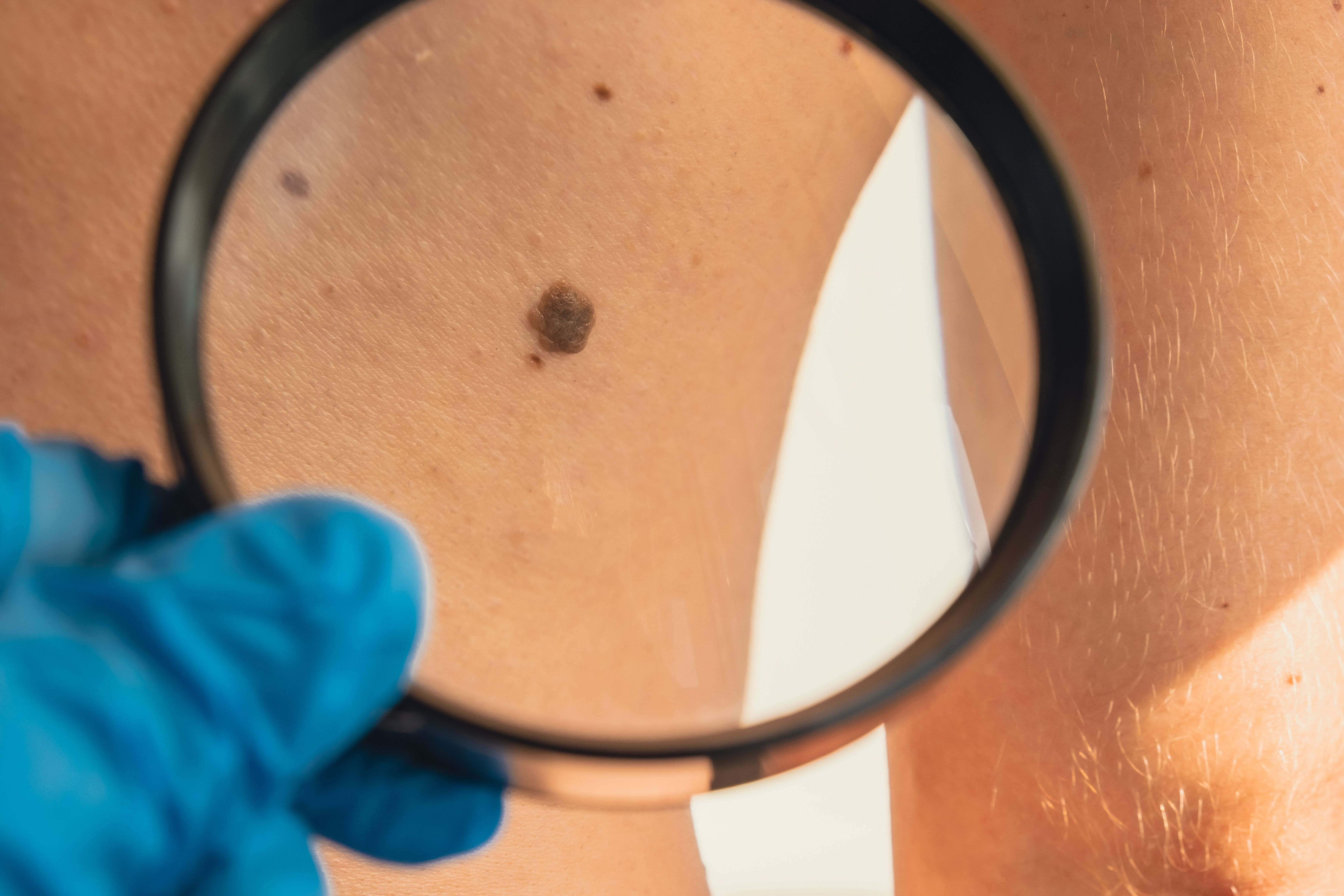Loss in skeletal muscle (SM) and changes in density of subcutaneous adipose tissue (SAT) in male patients and female patients, respectively, have now been linked to a greater likelihood of poor outcomes following chemoimmunotherapy for non–small cell lung cancer (NSCLC), according to findings from 3 studies published online today in JAMA Oncology.1
For this analysis of how body composition (BC) might affect the impact of immunotherapy used to treat non–small cell lung cancer (NSCLC), investigators from Dana-Farber Brigham Cancer Center (DFBCC) compared patient outcomes based on baseline BC measurements or first follow-up scan. The principal outcome was HR for potential links between BC measurements and overall survival (OS) and progression-free survival (PFS).
Key Findings
- Loss of skeletal muscle mass was indicative of worse outcomes across all patient groups
- Poorer overall survival was seen among the 2 patient groups from Dana-Farber Brigham Cancer Center and Study 108 who had a subcutaneous adipose tissue increase of more than 5%
- Change in skeletal muscle mass was more a marker of poor prognosis among male patients
- Change in subcutaneous adipose tissue density was more a marker of poor prognosis among female patients
The data for this analysis encompassed 487 patients who received chemoimmunotherapy at DFBCC, 825 patients who received immune checkpoint inhibitor (ICI) treatment at DFBCC, 222 patients who received durvalumab monotherapy on the phase 1/2 Study 1108, and 257 patients who received chemotherapy on the phase 3 MYSTIC study. Study 1108 and MYSTIC investigated MEDI4736 (durvalumab) for use in adult patients with solid tumors.2,3 Baseline and follow-up CT scans were used for body imaging, deep neural networks were used to gauge BC segmentation (SM, SAT, and visceral adipose tissue [VAT]) and to automatically select L3 slices, and all data were analyzed between July 2022 and April 2023.
Less than half of this population were women (49%), and median (IQR) patient ages were nearly the same across the 4 groups: 65 (58-74), 66 (57-71), 65 (26-87), and 63 (30-84) years, respectively. All had documented stage III/IV NSCLC.
“The association between [BC] and cancer outcomes is complex and incompletely understood,” study authors wrote. “Previous research in NSCLC has been limited, and yielded promising, albeit heterogeneous, results.”
Overall, loss of SM mass, measured by change in L3 SM area, was indicative of worse outcomes across all patient groups. Among the 487 patients who received chemoimmunotherapy at DFBCC, this was seen for both OS (HR, 0.59; 95% CI, 0.43-0.81) and PFS (HR, 0.61; 95% CI, 0.47-0.79). For the 825 patients who received ICIs at DFBCC, this was seen for OS (HR, 0.74; 95% CI, 0.60-0.91). Within the 222 patients treated in Study 108, OS (HR, 0.46; 95% CI, 0.33-0.64) and PFS (HR, 0.47; 95% CI, 0.34-0.64) were both reduced. Among the 257 patients treated in MYSTIC, this was seen for PFS (HR, 0.76; 95% CI, 0.61-0.96) for PFS. These outcomes were seen more among male patients, the study authors said.
Another main finding was the poorer OS seen among the patients in the DFBCC chemoimmunotherapy (HR, 0.61; 95% CI, 0.43-0.86) and ICI (HR, 0.62; 95% CI, 0.49-0.79) cohorts and Study 108 (HR, 0.56; 95% CI, 0.40-0.77) who had an SAT increase of more than 5%. Female patients were more likely to experience these outcomes, the authors wrote.
These additional findings were also seen:
- In the chemoimmunotherapy cohort:
- ECOG performance status (PS) (HR, 1.559; 95% CI, 1.081-2.246; P = .02) and PD-L1 status (HR, 0.992; 95% CI, 0.986-0.999; P = .04) were associated with OS
- PD-L1 expression level (HR, 0.991; 95% CI,0.985-0.997; P = .002) was associated with PFS
- Men had higher baseline SM area (SMa) and VAT and women had higher baseline SAT
- In the ICI cohort:
- ECOG PS (HR, 1.87; 955 CI, 1.49-2.35; P < .001), tumor mutational burden (TMB) (HR, 0.95; 95% CI, 0.93-0.98; P < .001), PD-L1 status (HR, 0.61; 95% CI; 0.40-0.91; P = .02), and line of therapy (HR, 1.23; 95% CI, 1.05-1.43; P = .01) were associated with OS
- ECOG PS (HR, 1.448; 95% CI, 1.180-1.775; P < .001) and TMB (HR, 0.950; 95% CI, 0.930-0.970; P < .001) were associated with PFS
- Men had higher baseline SM area (SMa) and VAT and women had higher baseline SAT
- In the Study 1108 cohort:
- Baseline ECOG PS (HR, 1.483; 95% CI, 1.136-1.937; P = .004) and PD-L1 status (HR, 0.995; 95% CI, 0.992-0.998; P < .001) were associated with OS
- ECOG PS (HR, 1.358; 95% CI, 1.046-1.763; P < .05) had an independent association with PFS
- Change in SMa had significant associations with OS (HR, 0.462; 95% CI, 0.334-0.641; P < .001) and PFS (HR, 0.465; 95% CI, 0.337-0.641; P < .001)
- Change in SAT density (SATd) had significant associations with OS (HR, 0.558; 95% CI, 0.402-0.774; P < .001) and PFS (HR, 0.709; 95% CI, 0.529-0.949; P < .05)
- In the MYSTIC cohort:
- ECOG PS had a significant association with OS (HR, 1.436; 95% CI, 1.122-1.838; P = .004)
- Baseline SATd had significant associations with OS (HR, 1.013; 95% CI, 1.004-1.022; P = .004) and PFS (HR, 1.009; 95% CI, 1.000-1.017; P < .05)
- Baseline SM density was associated with OS (HR, 0.9848; 95% CI, 0.976-0.993; P < .001) and PFS (HR,0.991; 95% CI, 0.983-0.999; P < .05)
- Men had higher baseline SMa and VAT
“Our findings highlight the importance of surveillance imaging in monitoring disease response to therapy and assessing potentially prognostic global BC features,” the study authors wrote. “They also have clinical implications that extend beyond the need for close surveillance of patients undergoing oncologic treatment to monitor for changes in radiologic features that indicate a poor outcome.”
They suggest there is potential for BC measures taken via CT to be used for decision making around NSCLC systemic therapies, but that large-scale data analysis is necessary to evaluate BC measures against treatment toxicities and oncologic outcomes. Also, there is a significant relationship between loss of SM mass and poor predicted outcomes in patients with advanced NSCLC receiving systemic treatment, and that future studies should investigate these relationships.
References
1. Chaunzwa TL, Qian JM, Li Q, et al. Body composition in advanced non-small cell lung cancer treated with immunotherapy. JAMA Oncol. Published online May 23, 2024. doi:10.1001/jamaoncol.2024.1120
2. A phase 1/2 study to evaluate MEDI4736. ClinicalTrials.gov. Updated May 13, 2021. Accessed May 23, 2024. https://clinicaltrials.gov/study/NCT01693562
3. Phase III open label first line therapy study of MEDI 4736 (durvalumab) with or without tremelimumab versus SOC in non small-cell lung cancer (NSCLC) (MYSTIC). ClinicalTrials.gov. Updated April 18, 2024. Accessed May 23, 2024. https://classic.clinicaltrials.gov/ct2/show/NCT02453282





